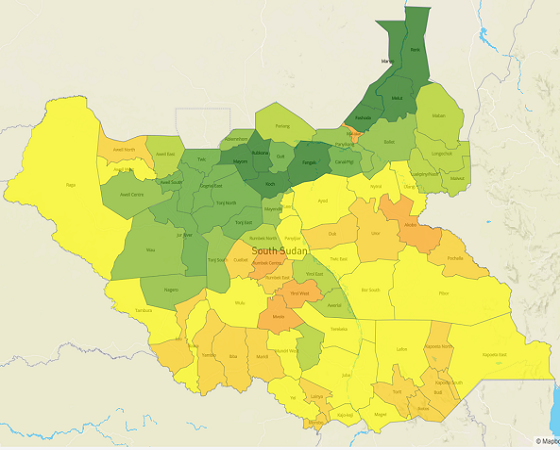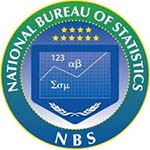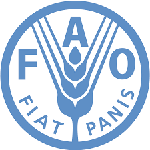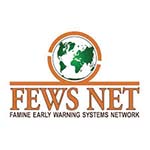Crop Assessment
The overall purpose of Crop Assessment is to provide accurate and up-to-date information on crop production. Crop and Food Security Assessment Missions (CFSAMs), jointly run by FAO and WFP with technical support of governmental institutions, have been conducted in South Sudan for many years and they are presently the only independent means of assessing the country’s production. CFSAM reports provide information on crop production, planted areas, livestock conditions, early warning of imminent food security problems and market information in deficit and surplus areas. Final aim of CFSAM reports is to provide accurate production information to guide local policy makers in their actions.
Crop assessment is a continuous activity that needs to be accomplished throughout the year. As an attempt to improve this situation, FAO South Sudan adopted an approach since 2014, with data collection and analysis carried out by Task Force teams that have been deployed to the field at critical planting and harvesting times throughout the cropping season, without concentrating all assessment activities at the end of the year. In 2016, the approach is further improving through involvement of county extension workers. To this effect County Crop Monitoring Committees are being established to monitor crops from the grassroots level.
Reports
Crop Watch Bulletin - South Sudan March, August 2023
Oct 25th 2023Rains started late across the country, with the bimodal areas receiving their first rains in April and the unimodal areas in late May. Normally the rains in bimodal areas start in March and in unimodal areas at the beginning of May. The rainfall amount was to be below average at the beginning, followed by period of dry spells across the country which lasted two to three weeks on average, from the third dekad of June to second dekad of July. However, the rains have fully established since second and third dekad of July creating favourable conditions for a quick recovery of stressed crops and replanting and planting operations in most cropping areas.
DownloadSouth Sudan 2022 Crop and Food Security Assessment Mission (CFSAM) Summary of findings
Mar 9th 2023The 2022 net cereal production (after deduction of post-harvest losses and seed use) in the traditional sector is estimated at about 936 200 tonnes, 11.5 percent above the 2021 output and 15.8 percent above the average of the previous five years (2017-2021). Despite the slightly late onset of rainfall, the increase in cereal production compared to the previous year was driven by an expansion of harvested area and favourable rains over most cropping areas, which benefited yields. With a projected population of about 12.9 million in mid-2023, the overall cereal deficit in the January-December 2023 marketing year is estimated at about 485 400 tonnes, 10.2 percent below the deficit estimated for 2022, and two percent below the 2018-2022 average.
Download2021 FAO/WFP Crop and Food Security Assessment Mission (CFSAM) to the Republic of South Sudan
Jun 16th 2022The 2021 net cereal production (after standardized deduction of post-harvest losses and seed use) in the traditional smallholder sector is estimated at about 839 500 tonnes, 4 percent below the 2020 output and well below the pre-conflict levels. The year?on?year decrease in cereal production is mainly driven by reduced yields due to prolonged dry spells and widespread floods, which had offset a slight increase in harvested area. Significant flood-induced crop production shortfalls occurred in Warrap and Jonglei states, where cereal production in 2020 was already at very low levels.
DownloadSouth Sudan 2019 Crop and Food Security Assessment Mission: Crop performance findings of the 2019 c
Mar 13th 2020The 2019 net cereal production (after deduction of post-harvest losses and seed use) in the traditional sector is estimated at about 818 500 tonnes, 10 percent above the 2018 output and 4 percent below the average of the previous five years. With a projected population of about 11.8 million in mid-2020, the overall cereal deficit in the January-December 2020 marketing year is estimated at about 482 500 tonnes, 7 percent below the deficit estimated for 2019, but still 22 percent above the 2015-2019 average. The increase in cereal production compared to the previous year was driven by abundant and well-distributed rains over most cropping areas increasing yields and by an expansion in harvested area.
DownloadSouth Sudan Crop Watch Updates from 1st Dekad of March to 3rd Dekad of July 2019
Sep 17th 2019The Crop Watch bulletin provides a general outlook on rainfall and crop performance in South Sudan and this report covers the period of March to July 2019. This report is based on crop planting assessments carried out in the field; crop monitoring reports from about 60 counties; remote-sensing products, including Normalized Difference Vegetation Index (NDVI), satellite-based rainfall estimates and data from locally installed rain gauges. Other sources such as the Vegetation Health Index (VHI) and the FAO’s Agricultural Stress Index (ASI) are also used. The analysis examines rainfall and crop performance in bimodal and unimodal areas of South Sudan during the period under review. Despite the accuracy of this analysis, the performance of crops may change rapidly within a short time depending on the rainfall situation across the country. Lack of long-term series of rainfall data as well as problems faced accessing information in most of the conflict-affected areas are some of the constraints faced in the production of this report.
DownloadReport on the FAO/WFP Crop and Food Security Assesment Mission (CFSAM) to South Sudan, 2019
Mar 18th 2019The net cereal production in 2018 (after deduction of post-harvest losses and seed use) in the traditional sector is estimated at about 745 000 tonnes, 15.5 percent below the average of the previous five years and 2.5 percent less than 2017. It is the smallest recorded output since the start of the conflict. Download the report for more details (PDF, 4MB)
DownloadSouth Sudan Crop Watch Updates to 3rd Dekad of July 2018
Sep 21st 2018This report provides a general outlook on rainfall and crop performance in South Sudan during the period of March - July 2018. The report is based on crop planting assessments carried out in the field; crop monitoring reports from more than 40 counties; remote-sensing products, including Normalized Difference Vegetation Index (NDVI), satellite-based rainfall estimates and data from local rain gauges. Others, such as the Vegetation Health Index (VHI) and the FAO Agricultural Stress Index (ASI) are also used. The analysis examines rainfall and crop performance in bimodal and unimodal areas of South Sudan during the period under review. Despite the accuracy of this analysis, the performance of crops may change rapidly within a short time depending on the rainfall situation across the country. Lack of long-term series of rainfall data as well as problems faced accessing information in most of the conflict-affected areas are some of the constraints faced in the production of this report.
DownloadSouth Sudan Crop Watch, Overview of Cereal Production in 2017
Feb 19th 2018An FAO/WFP Crop and Food Security Assessment Mission (CFSAM) visited South Sudan from 4 to 14 December 2017 to estimate cereal production during 2017 and assess the overall food security situation. The CFSAM reviewed the findings of several crop assessment missions conducted at planting and harvest time in the different agro-ecological zones of the country from May to December 2017. As during 2014, 2015 and 2016, all assessment missions were carried out by a Task Force team that comprised staff from the Ministry of Agriculture and Food Security (MAFS) drawn from national and state offices, the National Bureau of Statistics (NBS) and the Food and Agriculture Organization of the United Nations (FAO). Task Force team members have been trained in the past years to conduct rapid assessments using established protocols and techniques, such as driving and walking transects, evaluating standing crops according to yield and livestock according to body condition, perform key informant interviews and farmer case studies. In addition, supported by the FAO, 39 County Crop Monitoring Committees (CCMCs) have been formed in 2016 and 2017, with a view to extending the responsibility of collecting more objective data at local level.
DownloadSouth Sudan Crop Watch Updates from 1st Dekad of August to 3rd Dekad of September 2017
Nov 2nd 2017This is the second crop watch report that describes the overall situation of rainfall and the performance of crops in South Sudan for the period of August to September 2017. The contents of the report are based on crop harvest assessments carried out in the field by:
- the South Sudan National Crop Monitoring Taskforce members from Food and Agriculture Organization of the United Nations (FAO), Ministry of Agriculture and Food Security (MAFS), National Bureau of Statistics (NBS) and some of the states;
- County Crop Monitoring Committees (CCMCs) drawn from agriculture staff located at county level currently operational in 38 counties.
The report has also utilized remote-sensing products, including Normalized Difference Vegetation Index (NDVI), the Vegetation Health Index (VHI) and the FAO Agricultural Stress Index (ASI1) as well as satellite-based rainfall estimates and data from the network of local rain gauges in the country. The report summarizes rainfall and crop performance in bi-modal and uni-modal areas of South Sudan during the months of August and September 2017. However, the performance of crops may change rapidly over the coming weeks depending on the rainfall situation, particularly for the bi-modal areas and some areas expecting harvests for long-maturing sorghum up to the end of December. Lack of long-term series of rainfall data, as well as lack of access to many conflict-affected field locations are among the principle challenges in the production of this report.
DownloadSouth Sudan Crop Watch Updates to 3rd Dekad of July 2017
Aug 10th 2017This report provides a general outlook on the rainfall and crop condition in South Sudan during the period of March – July 2017. The report is based on planting assessments carried out in the field; crop monitoring reports from more than 30 counties; remote-sensing products, including Normalized Difference Vegetation Index (NDVI), satellite-based rainfall estimates and data from local rain gauges as well as the Vegetation Health Index (VHI) and the FAO Agricultural Stress Index (ASI)1. The analysis examines rainfall and crop performance in bi-modal and uni-modal areas of South Sudan during the months of March to July 2017. However, the performance of crops may change rapidly over the coming weeks and months depending on the rainfall situation across the country. The lack of long-term series of rainfall data as well as problems faced accessing information in most of the conflict-affected areas are some of the constraints faced in the production of this report.
DownloadFAO/WFP Crop and Food Security Assesment Mission to South Sudan
Aug 2nd 2016An FAO/WFP Crop and Food Security Assessment Mission (CFSAM) visited South Sudan from 30 November to 18 December 2015 to estimate cereal production during 2015 and assess the overall food security situation. The CFSAM reviewed the findings of several crop assessment missions conducted at planting and harvest time in the different agro-ecological zones of the country from May to December 2015. As during 2014, all assessment missions were carried out by a Task Force team that comprised staff from the Ministry of Agriculture, Forestry, Cooperatives and Rural Development (MAFCRD), the National Bureau of Statistics (NBS) and FAO.
Download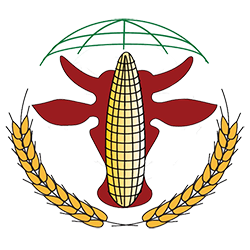 CLiMIS
CLiMIS 

